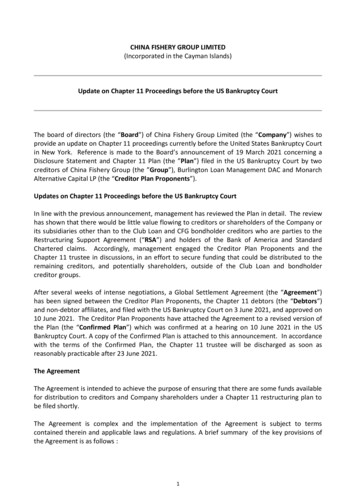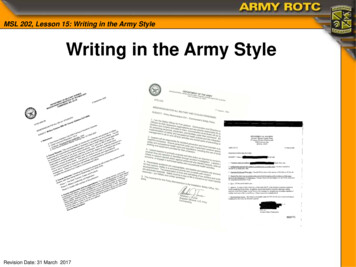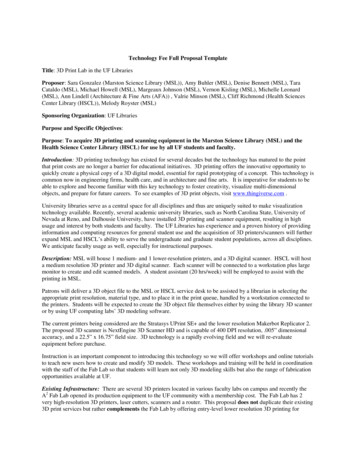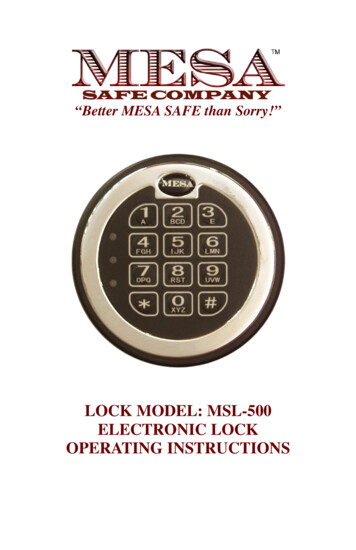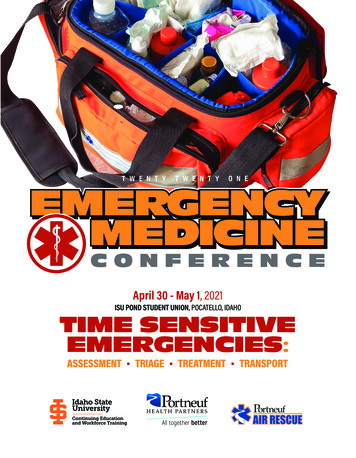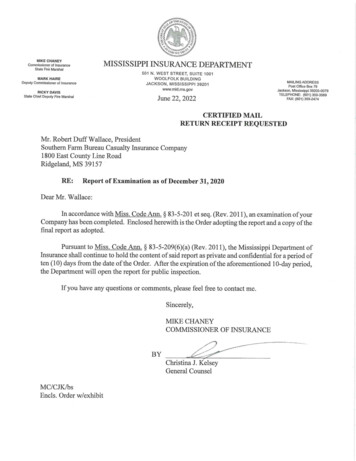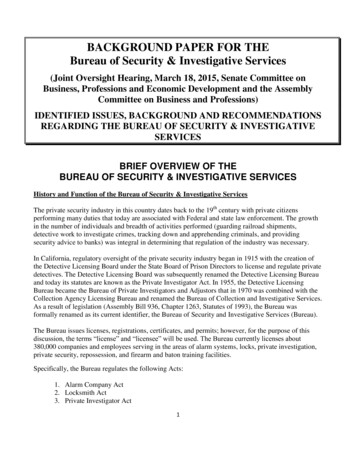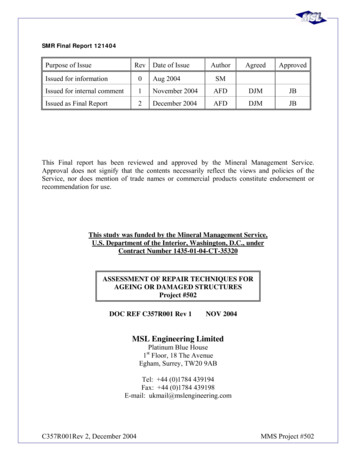
Transcription
SMR Final Report 121404Purpose of IssueRevDate of IssueAuthorAgreedApprovedIssued for information0Aug 2004SMIssued for internal comment1November 2004AFDDJMJBIssued as Final Report2December 2004AFDDJMJBThis Final report has been reviewed and approved by the Mineral Management Service.Approval does not signify that the contents necessarily reflect the views and policies of theService, nor does mention of trade names or commercial products constitute endorsement orrecommendation for use.This study was funded by the Mineral Management Service,U.S. Department of the Interior, Washington, D.C., underContract Number 1435-01-04-CT-35320ASSESSMENT OF REPAIR TECHNIQUES FORAGEING OR DAMAGED STRUCTURESProject #502DOC REF C357R001 Rev 1NOV 2004MSL Engineering LimitedPlatinum Blue House1st Floor, 18 The AvenueEgham, Surrey, TW20 9ABTel: 44 (0)1784 439194Fax: 44 (0)1784 439198E-mail: ukmail@mslengineering.comC357R001Rev 2, December 2004MMS Project #502
NUMBERDETAILS OF REVISION0Issued for information, August 20041Issued for comment, November 2004.throughout, including restructuring of report.2Issued as Final Report, December 2004. Conversion table added,Figure showing clamp details to avoid added, and general editorialrevisions.C357R001Rev 2, December 2004Extensive revisionsMMS Project #502
Assessment of Repair Techniques forAgeing or Damaged StructuresByDr. Adrian F DierMSL Services CorporationFinal Project Report:ASSESSMENT OF REPAIR TECHNIQUES FORAGEING OR DAMAGED STRUCTURESMMS Project Number 502November 2004C357R001Rev 2, December 2004i
This Final report has been reviewed and approved by the Mineral ManagementService. Approval does not signify that the contents necessarily reflect the viewsand policies of the Service, nor does mention of trade names or commercialproducts constitute endorsement or recommendation for use.For more information contact:MSL Services Corporation11111 Katy Freeway, Suite 620Houston, Texas 77079OrMSL ENGINEERING LIMITEDPlatinum Blue House1st Floor, 18 The AvenueEgham, Surrey TW20 9ABUnited KingdomNovember 2004C357R001Rev 2, December 2004ii
ASSESSMENT OF REPAIR TECHNIQUES FORAGEING OR DAMAGED STRUCTURESMMS Project #502Dr A F DierMSLC357R001Rev 2, December 2004iii
UNITED STATES DEPARTMENT OF THE INTERIORMINERALS MANAGEMENT SERVICESASSESSMENT OF REPAIR TECHNIQUES FORAGEING OR DAMAGED STRUCTURESMMS Project #502Table of ContentsPage NoEXECUTIVE SUMMARY . 1PART I – OVERVIEW AND SELECTION OF SMR SCHEMES/TECHNIQUES . 81.2.INTRODUCTION . 91.1Background . 91.2Objective and Scope of Work . 101.3How to Use This Document. 121.4List of Terms and Abbreviations . 15PAST, PRESENT AND FUTURE PERSPECTIVES . 182.1Assessment Technology. 182.2SMR Techniques. 192.3Diverless SMR . 213.ASSESSMENT INITIATORS. 255.SELECTION OF SMR SCHEME & TECHNIQUES. 325.1Selection of SMR Scheme . 32C357R001Rev.2 December 2004Page iv
5.1.1 Remove Damage. 325.1.2 Reduce Loadings. 335.1.3 Localized Strengthening /Modification/Repair. 335.1.4 Global Strengthening/Modification/Repair . 345.1.5 Total Strengthening/Modification/Repair. 355.2Selection of SMR Techniques . 35PART II – DETAILS OF SMR TECHNIQUES . 466.MEMBER REMOVAL . 486.1Description. 486.1.16.1.27.General. 48Cutting Techniques . 496.2Limitations . 536.3Design Approach . 536.4Fabrication/Installation Issues . 546.5Previous Offshore Applications. 55DRY WELDING . 587.1Description of Techniques . 587.1.1 Dry Welding at One Atmosphere . 587.1.2 Dry Hyperbaric Welding. 597.1.3 Hyperbaric Welding Processes . 628.7.2Limitations . 637.3Design Approach . 647.4Fabrication/Installation Issues . 657.5Previous Offshore Applications. 66WET WELDING TECHNIQUES . 728.1Description of Technique. 728.1.18.1.28.2General. 72Welding Processes . 73Limitations . 75C357R001Rev.2 December 2004Page v
9.8.3Design Approach . 768.4Fabrication/Installation Issues . 768.5Previous Offshore Applications. 77STRUCTURAL CLAMPS . 849.1Description. 849.1.19.1.29.1.39.1.49.1.59.1.6Introduction. 84Stressed-Mechanical (Friction) Clamps. 85Unstressed Grouted Clamps/Sleeve Connection . 87Stressed Grouted Clamps. 92Stressed Elastomer-Lined Clamps . 93Other Types of Clamps . 949.2Limitations . 969.3Design Approach . 979.3.1 General. 979.3.2 Design Procedure for Stressed Clamps. 1029.3.3 Slip strength formulations. 1049.3.4 Details to Avoid . 1079.510.11.Previous Offshore Applications. 110GROUT-FILLING OF MEMBERS . 11410.1Description. 11410.2Limitations . 11410.3Design Approach . 11510.4Fabrication/Installation Issues . 11610.5Previous Offshore Applications. 116GROUT-FILLING OF JOINTS . 12011.1Description. 12011.2Limitations . 12111.3Design Approach . 122C357R001Rev.2 December 2004Page vi
12.11.4Fabrication/Installation Issues . 12211.5Previous Offshore Applications. 123WELD IMPROVEMENT THECHNIQUES. 12612.1General. 12612.2Toe Grinding. 12612.2.112.2.212.2.312.2.412.2.512.3Shot, Needle, Hammer and ultrasonic Peening . tion. 126Limitations . 127Design Approach . 128Fabrication/Installation Issues . 129Previous Offshore Applications. 131Description. 131Limitations . 132Design Approach . 132Fabrication/Installation Issues . 133Previous Offshore Applications. 134Other Weld Improvement Techniques. 135REMEDIAL GRINDING . 14013.1Description. 14013.2Limitations . 14113.3Design Approach . 14113.4Fabrication/Installation Issues . 14113.5Previous Offshore Applications. 142BOLTING . 14614.1Description. 14614.2Limitations . 14814.3Design Approach . 14814.4Fabrication/Installation Issues . 149C357R001Rev.2 December 2004Page vii
14.515.16.Previous Offshore applications . 151FIBER REINFORCED POLYMER (FRP) COMPOSITES . 15415.1Description. 15415.2Limitations . 15515.3Design Approach . 15515.4Fabrication/Installation Issues . 16115.5Previous Offshore Applications. 161MISCELLANEOUS SMR TECHNIQUES. 16916.1General. 16916.2Adhesives and Patch Plates. 16916.2.116.2.216.2.316.2.416.2.516.3Mechanical Connectors. 17316.3.116.3.216.3.316.3.416.3.516.4Description. 169Limitations . 170Design Approach . 170Fabrication/Installation Issues . 172Previous Offshore Applications. 173Description. 173Limitations . 174Design Approach . 174Fabrication/Installation Issues . 175Previous Offshore Application . 175Swaged Connections. 17516.4.116.4.216.4.316.4.416.4.5Description. 175Limitations . 176Design Approach . 177Fabrication/Installation Issues . 177Previous Offshore Applications. 178BIBLIOGRAPHY. 181CONVERSION TABLE. 184C357R001Rev.2 December 2004Page viii
EXECUTIVE SUMMARYGeneralThis document has been prepared by MSL, on behalf of the Mineral Management Services, forall those concerned with the Strengthening, Modification and Repair (SMR) of offshore steelinstallations.SMR is an important aspect of offshore engineering to ensure continued safe operation ofoffshore installations. However, it requires rather different skills and knowledge to normaljacket/topsides design and is considered by many to be specialist work. SMR operations tend tobe highly engineered, certainly for moderate and major works, in order to minimize the highcosts associated with offshore works. All too often, however, either inappropriate, unnecessaryor expensive SMR schemes have been deployed, primarily as a result of the lack ofskills/knowledge. This document has been written with the intent that such inappropriateschemes can be avoided, by guiding the engineer through the main ideas involved in selectingoptimal SMR scheme and individual SMR techniques.It is noted that with the exception of the rise of composite materials in SMR schemes, there hasbeen no fundamental change over the last decade in the available techniques to effect SMR.However, there have been some developments in welding consumables and in grout materials.A ‘road map’ of how to use this document, and which summarizes the relationship of the varioussections within this report, may be found in Section 1.3.InitiatorsThe SMR scheme and individual SMR technique selection process begins by gaining anappreciation of the causative agents that may, but not necessarily, lead to a requirement for SMR.These initiators can be summarized as falling into one of four categories:1.Change in platform operation2.Life extension3.Damage (or potential damage) caused by: Vessel collision Dropped object Fatigue Corrosion Mishandling during the installation process Fabrication / design fault Occurrence of design eventC357R001Rev 2, December 2004Page 1 of 184
4.Code updates or operator-led safety measures.Structural AssessmentA structural assessment will normally be required at the outset to ascertain whether or not somelevel of SMR is required, and if so to indicate the extent of the required SMR scheme. Thestructural assessment comprises both platform analysis (to establish member loads or theresistance of the whole platform to design events) and code or other checks on the (intact ordamaged) component capacity. Whereas it is normal engineering design practice to conductsimple linear analysis and code checks (e.g. to API RP2A) for demonstrating the structuraladequacy of new build structures, it will often prove beneficial in potential SMR situations to userefined or advanced analysis techniques and/or component checks falling outside the scope ofstandard codes. In many cases such refined/advanced analysis or component checks willdemonstrate that the structure is fit-for-purpose and that no SMR is required. A staged approachto the assessment is recommended, where the results of each stage are reviewed to decide on themerits of further refining the analysis and/or component checks. This process is summarized inthe figure below.InputdataPlatformanalysisPost-process &code checksDocumentfindingsOKNOTOKPossible outcome:z Specific inspectionYESReview findings,is it worth refininganalysis/checks?NOz Load reductionz Strengthen/Repairz Change operatingproceduresOverall assessment approachThe quality of the input data has a significant bearing on the success of above assessmentprocess. The as-built structural geometry, together with any subsequent modifications, shouldform the basis of the model. It will usually prove advantageous to have knowledge of the actualyield strength (e.g. from traceable mill certificates) of the materials used in the fabrication asthese can be 15% or more, higher than the specified minimum yield strength (SMYS).The possibilities for refining the analysis, and the possibilities for improved component checkingare summarized in the tables below. It should be noted that these refinements and improvementsC357R001Rev 2, December 2004Page 2 of 184
are independent of each other, e.g. refined code checking can be, and often is, used inconjunction with the results from a basic analysis.ANALYSISPOST-PROCESSING /CODE-CHECKINGBASIC ANALYSIS As-built modifications Node-to-node stick model Remove damaged member?STANDARD CODE CHECK (API RP2A) Yield based on SMYSSIMPLE REFINED ANALYSIS Member eccentricities/offsets Remove double counting of wave load Residual stiffness of damaged memberREFINED P-P / C-C Yield based on Mill Certificates. Review member effective lengths Review SCFsCOMPLEX REFINED ANALYSIS Local Joint Flexibilities (LJFs) Hindcast site data Probabilistic loading combinations Appraise capacity of damaged elementsADVANCED ANALYSIS (PUSHOVER) Non-linear member behaviour Non-linear joint behaviourADVANCED P-P / C-C Conduct FEA component study Commission tests- Assessment of existing test data- Conduct Fracture Mechanics study Reliability analysisAssessment Outcome and SMR Scheme selectionAt the end of the assessment phase, it will be known that either no SMR is called for or that oneof four outcomes should be pursued:1.Specific inspection requirements are drawn up, for instance to monitor a defect.2.A load reduction program is instigated. This may encompass removal of redundanttopsides equipment, redundant members (as demonstrated in the assessment phase) orsimply the removal of excess marine growth to reduce drag loading.3.Some level of SMR is warranted.4.Operating procedures are changed, e.g. manning/de-manning philosophy or direction ofapproach of service vessels.In the case of item 3, when some level of SMR is proposed, four levels of remedial works ofincreasing complexity can be identified:1.Remove damage (e.g. grinding out of cracks or removal of bent/bowed member).2.Local SMR (defined as when no change of system load path occurs as a result of theSMR scheme – e.g. the introduction of a clamp around a member or joint is considered tobe a local SMR).C357R001Rev 2, December 2004Page 3 of 184
3.Global SMR (defined as when a change of system load path does occur – typically whenan additional member is introduced). Note that a global SMR scheme may include somelocal SMR elements.4.Total SMR (this entails major works such as tying in to a new adjacent structure). Notethat a total SMR scheme will necessarily include some global SMR elements.It should be apparent that for the global and total SMR schemes, the structure needs to be reanalyzed and checked to demonstrate that the proposed SMR scheme will achieve the requiredlevel of structural integrity.SMR TechniquesHaving selected the level of SMR, the individual SMR technique (or techniques) has to bechosen to realize the SMR scheme. In most cases there are alternatives that would achieve thisobjective; although in many instances, particularly for local SMR schemes, the choice may befairly obvious. The selection of SMR technique(s) requires: knowledge of the available range oftechniques, including variants; their strengths and weaknesses; and an appreciation of otherfactors such as ease of design, buildability, offshore support and equipment requirements, localsupply infrastructure, etc.A summary of the main SMR techniques that are available is presented in the figure below. (Amore complete chart is given in the main text of this document.) The techniques at the bottom ofthe chart that are highlighted in red are considered to have limited application at the present time.Further detailed information on each technique is presented in Part 2 of this document.STRENGTHENING / MODIFICATION / REPAIR TECHNIQUESWELDINGCLAMP TECHNOLOGYGROUT FILLINGWELD IMPROVEMENTOTHER TECHNIQUESDRY WELDING- Atmospheric- HyperbaricMECHANICALCLAMPOF MEMBERSTOE GRINDING,PROFILE GRINDINGREMEDIAL GRINDINGOF CRACKSWET WELDINGGROUTEDCLAMP/SLEEVE- Unstressed- StressedOF JOINTSHAMMER PEENINGCOMPOSITES- Glass fibre- Carbon fibreMEMBER REMOVALNEOPRENE-LINEDCLAMPOTHER- Friction- StitchBOLTINGOTHER- Toe remelting- Needle/shot peeningOTHER- Adhesives- Swaged connections- Mechanical connectionsMain SMR techniques that are availableC357R001Rev 2, December 2004Page 4 of 184
The various techniques lend themselves to address one or more commonly occurring scenarios asindicated in the table below.TechniqueDry weldingWet weldingToe grindingRemedial grindingHammer peeningStressed mechanical clampUnstressed grouted clampStressed grouted clampNeoprene-lined clampGrout-filling of membersGrout filling of jointsBoltingMember onononoyesyesnoyesyesnoyes(5)yesDefectCorrosion Inadequate static syesNotes: (1) Usually in conjunction with additional strengthening measures(2) Except to apply weld beads in unstressed grouted connection/clamp repairs(3) To apply patch plates(4) Applicability depends on type and sense of loading(5) If member is redundant (otherwise replace it)Inadequate fatigue strengthhigh loadsfabr. oyes(4)noyes(4)nononoyes(5)yes(5)yesyesColor codingApplicable Not applicableApplicability of SMR techniquesHowever, for a given scenario, some techniques offer better advantages than others in terms ofoffshore equipment requirements, timescales, costs and loading penalties, as indicated below.Design BackgroundStaticFatigueStrength nTimescalesDry weldingyesyesheavyvery slowWet weldingToe grindingRemedial grindingHammer peeningStressed mechanical clampsUnstressed grouted clampsStressed grouted clampsNeoprene-lined clampsGrout fillingBoltingMember bricationCostshigh wlownonemoderateLoad enonenonehighmoderatehighhighnonelownonelowNotes: * MSL has proprietary informationBadPoorColor coding applies vertically not horizontallyOKGoodComparison of SMR techniquesIn the above table, it can be seen that dry welding carries severe cost and timescale penalties –mainly in respect of the need to construct either a cofferdam (for shallow repairs) or a hyperbarichabitat. Where wet welding is not considered feasible, then clamp technology must be employedto introduce new members into the structure or to reinforce nodal joints. A summary of theadvantages and disadvantages of the individual techniques is presented in the table below.C357R001Rev 2, December 2004Page 5 of 184
TechniqueAdvantagesDisadvantagesDry weldingUniversally accepted from atechnical standpoint.Wet weldingProven technique. Relativelyquick method.Toe GrindingDoubles fatigue life.Remedial GrindingProven technique. Relativelyquick method for arrestingfatigue cracks.Very effective method forincreasing fatigue life.Proven technique. Immediatecapacity realized ontensioning studbolts. Can beused as an end connection tointroduce new members intothe structure.Hot work permit required.Below the waterline, requiresthe construction of eithercofferdam or hyperbarichabitat - both being timeconsuming and expensive.The cofferdam, in particular,will attract high waveloading.Not accepted in all parts ofthe world. Weld propertiesnot as good as dry welds,although this can beaccounted for in the design.Only applicable for fatiguelife extension.Static strength needs to beassessed.Hammer PeeningStressed Mechanical ClampUnstressed Grouted ClampStressed Grouted ClampC357R001Rev 2, December 2004Only applicable for fatiguelife extension.Poor tolerance acceptabilityprecludes use around nodaljoints or over girth jointsbetween tubular cans. Weldsand other protuberances haveto be ground flush orotherwise accommodated indepressions machined insaddle plate.Proven technique. HighClamps are relatively longtolerance acceptability. Can be unless they, and the clampedused as an end connection tomember, are provided withintroduce new members intoweld beads.the structure.Proven technique. HighThere is a requirement totolerance acceptability.allow the grout to cureClamps are relatively short.sufficiently before returningCan be used as an endto tension the studbolts.connection to introduce newmembers into the structure.Page 6 of 184
TechniqueNeoprene-lined ClampAdvantagesSome tolerance acceptability.Can be used as an endconnection to introduce newmembers into the structure.Grout-filling of MemberProven technique. Relativelyquick method.Grout-filling of JointsProven technique. Relativelyquick method. Good forimproving both static andfatigue strengths.BoltingMember RemovalGood for topsides SMR.Proven technique. Relativelyquick methodLightweight strengthening andrepairs are possible. No hotwork.CompositesDisadvantagesFriction coefficient is lowerthan generally realized.Neoprene introducesflexibility, therebycompromising its ability totake up load if alternate loadpaths exist.Weight p
C357R001Rev 2, December 2004 ii For more information contact: MSL Services Corporation 11111 Katy Freeway, Suite 620 Houston, Texas 77079

